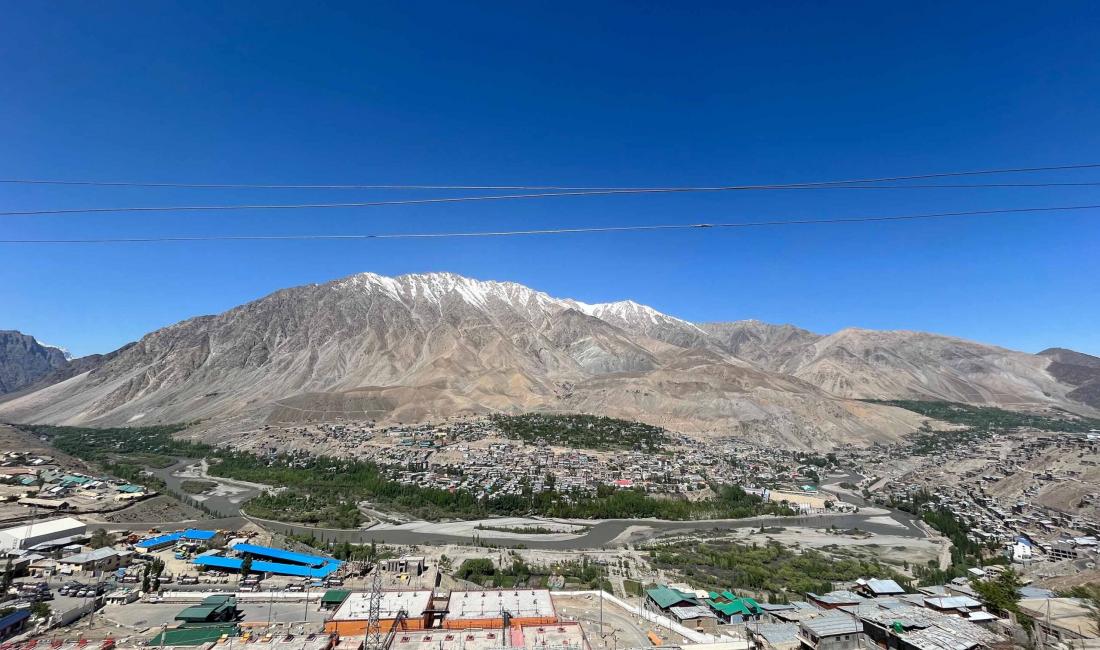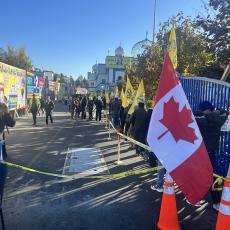In Indian Union Territory of Ladakh, two districts set aside differences and come together to protect their homeland.
This special feature was produced and published by Asia Democracy Chronicles. An aerial view of Kargil, a Muslim-majority town, in India’s Ladakh which is predominantly populated by Buddhists. (Photo: Zaid Bin Shabir)
Years of being neglected and ignored have pushed India’s erstwhile divided Ladakhis to unite and vote against candidates of major political parties in the country’s recently concluded general election.
And while Ladakh has just one seat in the lower house of the Indian parliament, the Union Territory’s lone representative is expected to protect not only its interests, but also, in many ways, that of the rest of India and even beyond.
Located in the country’s northeast, Ladakh is next door to Pakistan and China, making it crucial and strategic to India’s security. It is also part of the Himalayan highlands, whose glaciers are the source of many Asian rivers, including the Indus and Ganges, as well as the Mekong, Yangtze, and Salween.
Ladakhis, especially the nomadic herders in the border areas, have repeatedly complained of Chinese incursions into Indian territory. But prominent local personalities like 2018 Ramon Magsaysay Awardee Sonam Wangchuk say that the government led by Prime Minister Narendra Modi has done little about these.
Meanwhile, late last year, the Ladakh administration – essentially representing the central government under the Union Territory set-up – issued a draft industrial land allotment policy that would allow outsiders into Ladakh’s manufacturing sector; many noted as well that the draft policy did not mention the region’s influential hill councils, which had been the bodies deciding on such matters.
“If Ladakh is opened up to outsiders, it will be a disaster for the environment and culture that has been fine-tuned for thousands of years,” Wangchuk, an innovator and activist, told Asia Democracy Chronicles (ADC). “Moreover, it will make refugees out of locals.”
He had made similar assertions in an interview published by The Week magazine, where he elaborated, “As an environmentalist, I am deeply worried about the fragile ecosystem of the high Himalayas, including Ladakh’s glacier system, known as the ‘third pole’ of the planet. These glaciers sustain around two billion people, including a quarter of the world’s population. Introducing mining industries in these areas would harm both local communities and cause water shortages affecting the entire north Indian plains.”
Many other Ladakhis share Wangchuk’s views. In fact, the draft policy seems to have added more momentum to a community crusade that has brought Ladakh’s two bickering districts together.
At loggerheads
Spread over 66,898 square kilometers and renowned for its rugged beauty, Ladakh is the largest parliamentary constituency in India in terms of area. But the primarily agricultural region has a population of only about 303,000, living in two districts: predominantly Muslim Kargil and predominantly Buddhist Leh.
Although they have now united for the common cause of protecting Ladakh, the relationship between Buddhist and Muslim Ladakhis had been strained by numerous incidents, including violent clashes, a six-year boycott of Muslims, and allegations of ‘love jihad.’
Kargil and Leh even had opposite reactions when the government led by Modi’s Bharatiya Janata Party (BJP) sliced off Ladakh from the state of Jammu and Kashmir in August 2019 and brought it under direct federal rule as a Union Territory. While Kargil erupted in protests, Leh lit fireworks, celebrating the change.
Under the Jammu and Kashmir government, Ladakhis from Leh had especially felt marginalized and underrepresented in state governance.
“In 2019, Ladakh supported and voted for the ruling BJP because it had repeatedly pledged to grant Ladakh a separate territory status,” said Padma Stanzin, coordinator at the Apex Body Leh (ABL), which represents several Buddhist religious and political parties. “However, in the past five years, they [BJP] have done nothing but harm Ladakh. There is a clear sense of insecurity in the region. Ladakh has become a bureaucratic system where officers call the shots.”
“When Ladakh was separated from Jammu and Kashmir, Buddhists initially celebrated, believing it freed them from Kashmiri influence,” said Dr. Tsering Phuntsog, former general secretary of the Ladakh Buddhists Association (LBA). “But later, we realized it was part of a larger governmental strategy of disenfranchising Ladakhis in their homeland.”
Ladakh had become a Union Territory, but without a legislature. For Ladakhis – both from Leh and Kargil — this brought fears about the impact of the constitutional change on their region’s cultural integrity and identity due to the newly given access to outsiders to purchase land and apply for jobs in Ladakh. The draft policy on industrial land allotment only fueled these fears some more.
A common cause
“It’s true that we [Leh] had been demanding Union Territory status,” said Chering Dorjay, a veteran Ladakhi Buddhist leader. “But we wanted it with a legislature. This makes a huge difference. Today Ladakh has absolutely no democracy and its governance has no say of the Ladakhi population. It’s only a federally governed region where all decisions are made at the behest of the [Delhi-appointed] Lieutenant Governor and bureaucracy.”
Phuntsog remarked that after the 2019 constitutional changes, both Buddhists and Muslim Ladakhis realized that their feud had been “a political tool used as a religious issue by vested interests,” and that no single community could demand safeguards for Ladakh separately.
“We needed to ask for these rights together,” he said, “so everyone benefits, not just one group.”
“When Muslim and Buddhist religious leaders stood together, it naturally brought the local people of both communities closer,” said Qamar Ali Akhoon, co-chairman of the Kargil Democratic Alliance. “For them, nothing is more important than preserving Ladakh’s identity.”
Last June 4, after being formally declared winner in the race for Ladakh’s lone Lok Sabha seat, Mohammed Haneefa Jan promised to pursue the movement’s four aims, saying, “I will raise the voice and the demands which Ladakh wants for its safeguards and development. My four demands include statehood for Ladakh, constitutional safeguards under Sixth Schedule, job reservations and setting up of a Public Service Commission (PSC), and two separate Parliament seats for Leh and Kargil districts.”
Foremost among those demands, however, are statehood and the safeguards under the Sixth Schedule, a provision of the Indian constitution that guarantees protections to land and a nominal autonomy for the country’s tribal areas. Statehood would mean a legislature for Ladakh, giving its people back their right to have a say in what happens in their region.
The Sixth Schedule gives additional safeguards that Ladakhis say are due them, since more than 90 percent of the locals belong to tribes such as the Balti Beda, Brokpa, Changpa, and Garra.
Feroz Ahmed Khan, a former Chief Executive Officer (CEO) of the Ladakh Autonomous Hill Development Council (LAHDC) Kargil, pointed out, “Under the Sixth Schedule, there are provisions for the protection of land, jobs, and the enactment of legislation. However, the Sixth Schedule without statehood holds little value.”
“How can the Indian government expect Ladakh’s environment to remain unscathed if it is opened up to corporate activities?” Khan asked. “We simply want the monitoring, planning, and governance to be solely in the hands of Ladakhi people, in the form of a state.”
Yet former Jammu and Kashmir Legislative Assembly member Asgar Ali Karbalai told ADC, “They’ve completely disregarded us and our movement.” Indeed, in frustration over the central government’s attitude, activist Wangchuk last March staged a 21-day hunger strike in Leh.
A long fight ahead
“What Ladakhis are asking for is well within the framework of the Constitution of India with ample precedence of Sixth Schedule protections being instituted in several places in the eastern Himalaya,” said noted South Asia-based political analyst Siddiq Wahid. “It’s difficult to imagine why the government is choosing to neglect the Ladakhis and even be belligerent, given recent revelations of the leaders of the protests at their last meeting with the government.”
He said that the central government has been “misjudging the real threat” that Ladakhis sense to their language, culture, ecology and traditional vocations. New Delhi, Wahid reckoned, is underestimating the resilience of the protests in Ladakh.
“There could be several reasons for it,” he said, referring to the government’s perceived indifference. “The size of Ladakh’s demography is one reason. Parallel to this is the fact that Ladakh is not arithmetically significant as a ‘vote bank,’ posing no risk to the incumbent’s electoral ambitions.”
But Wahid said that the government “is also discounting Ladakh’s role in threats to India’s national security, being as it is a region with boundaries contiguous to China and Pakistan, both rivals in the geostrategic politics of and for South Asia.”
A political analyst based in Jammu and Kashmir confirmed BJP’s stance of ignoring Ladakhis’ demands, saying, “When the BJP had a majority in 2019, it enforced silence in parliament, and protests about statehood and the Sixth Schedule were never heard.”
But that may start to change, even as Modi on June 9 was sworn in for a third term as India’s premier. The BJP had failed to achieve the supermajority it wanted from the recent election and will now be facing a stronger opposition in parliament. According to the analyst, the BJP is likely to reconsider its position on the Ladakhis’ demands, especially after losing a key area like Ladakh, which a BJP member had represented in parliament since 2014.
Ladakh’s new representative in the Lok Sabha had run as an independent. The analyst said that Jan will most probably align himself with the INDIA bloc, the alliance of opposition parties led by the Indian National Congress party, which “will definitely push for these demands in parliament.”
But the analyst said, “It will take some time for these demands to be addressed because the central government fears that fulfilling them might lead to similar demands from Kashmir, which is a situation they want to avoid.”
The Ladakhis, though, are not about to give up anytime soon. An activist from Leh, who has been leading the protests for statehood and the Sixth Schedule, told ADC that these “will resume and continue until the government fulfills our demands.”
Local leader Dorjay, who was once a BJP chief for Ladakh, also said, “The ongoing agitation is a prolonged struggle where Ladakh has to contend a lot with the BJP, and we are fully prepared for such a fight.”



